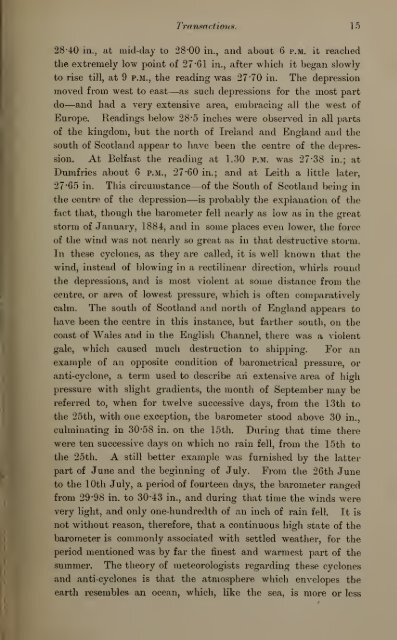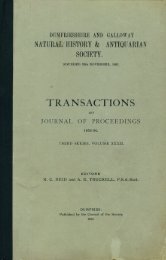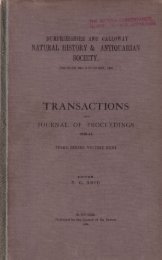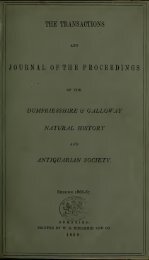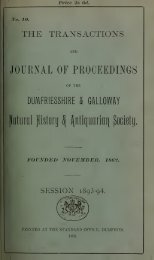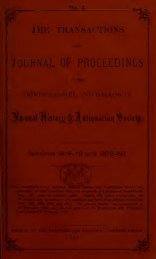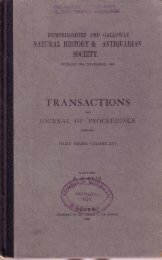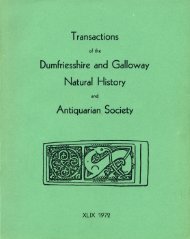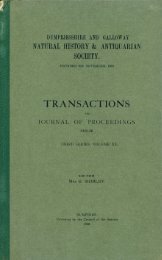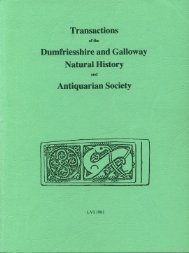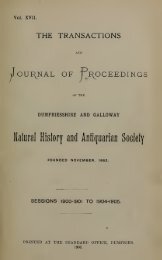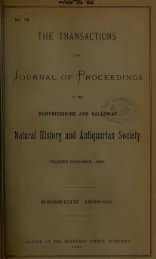Vol 5 - Dumfriesshire & Galloway Natural History and Antiquarian ...
Vol 5 - Dumfriesshire & Galloway Natural History and Antiquarian ...
Vol 5 - Dumfriesshire & Galloway Natural History and Antiquarian ...
Create successful ePaper yourself
Turn your PDF publications into a flip-book with our unique Google optimized e-Paper software.
Trannactions. 1528-40 in., at mid-day to 28-00 in., <strong>and</strong> about 6 p.m. it reachedthe extremely low point of 27-61 in., after which it began slowlyto rise till, at 9 p.m., the reading was 27-70 in. The depressionmoved from west to east—as such depressions for the most partdo—<strong>and</strong> had a very extensive area, embracing all the west ofEurope.Readings below 28-5 inches were observed in all partsof the kingdom, but the north of Irel<strong>and</strong> <strong>and</strong> Engl<strong>and</strong> <strong>and</strong> thesouth of Scotl<strong>and</strong> appear to have been the centre of the depression.At Belfast the reading at 1.30 p.m. was 27-38 in.; atDumfries about 6 p.m., 27-60 in.; <strong>and</strong> at Leith a little later,27-65 in. This circumstance—of the South of Scotl<strong>and</strong> being inthe centre of the depression—is probably the explanation of thefact that, though the barometer fell nearly asstorm of January, 1884, <strong>and</strong> inlow as in the greatsome places even lower, the forceof the wind was not nearly so great as in that destructive storm.In these cyclones, as they are called, it is well known that thewind, instead of blowing in a rectilinear direction, wliirls roundthe depressions, <strong>and</strong> is most violent at some distance from thecentre, or area of lowest pressure, which is often comparativelycalm. The south of Scotl<strong>and</strong> <strong>and</strong> north of Engl<strong>and</strong> appears toliave been the centre in this instance, but farther south, on thecoast of Wales <strong>and</strong> in the English Channel, there was a violentgale, which caused much destruction to shipping. For anexample of an opposite condition of barometrical pressure, oranti-cyclone, a term used to describe an extensive area of highpressure with slight gradients, the month of September may bereferred to, when for twelve successive days, from the 13th tothe 25th, with one exception, the barometer stoodabove 30 in.,culminating in 30-58 in. on the 15th. During that time therewere ten successive days on which no rain fell, from the 15th tothe 25th. A still better example was furnished by the latterpart of June <strong>and</strong> the beginning of July. From the 26th Juneto the 10th July, a period of fourteen days, the barometer rangedfrom 29-98 in. to 30-43 in., <strong>and</strong> during that time the winds werevery light, <strong>and</strong> only one-hundredth of an inch of rain fell. It isnot without reason, therefore, that a continuous high state of thebarometer is commonly associated with settled weather, for theperiod mentioned was by far the finest <strong>and</strong> warmest part of thesummer. The tlieory of meteorologists regarding these cyclones<strong>and</strong> anti-cyclones is that the atmospliere which envelopes theearth resembles an ocean, whicli, like the sea, is more or less


